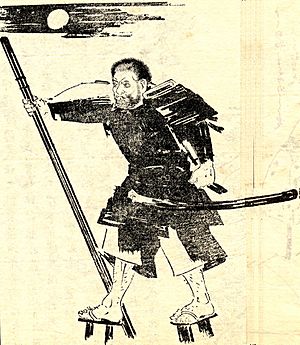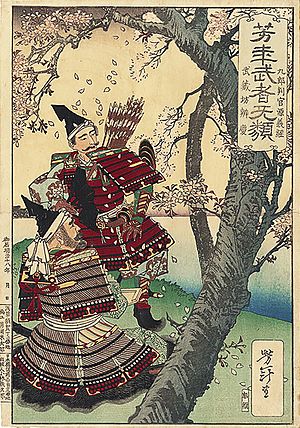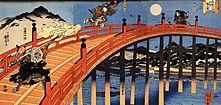Benkei facts for kids
Saitō Musashibō Benkei (西塔武蔵坊弁慶, 1155–1189), popularly known as simply Benkei, was a Japanese warrior monk (sōhei) who lived in the latter years of the Heian Period (794–1185)[1]. Benkei led a varied life, first becoming a monk, then a mountain ascetic, and then a rogue warrior. He later came to respect and serve the famous warrior Minamoto no Yoshitsune, also known as Ushiwakamaru. He is commonly depicted as a man of great strength and loyalty, and a popular subject of Japanese folklore, showcased in many ancient and modern literature and productions.
Contents
Early life

Stories about Benkei's birth vary considerably. ..... Another sees him as the offspring of a temple god. Many give him the attributes of a demon, a monster child with wild hair and long teeth. In his youth, Benkei may have been called Oniwaka (鬼若)—"demon/ogre child", and there are many famous ukiyo-e works themed on Oniwakamaru and his adventures. He is said to have defeated 200 men in each battle he was personally involved in.
Benkei chose to join the monastic establishment at an early age and traveled widely among the Buddhist monasteries of Japan. During this period, monasteries were not only important centers of administration and culture, but also military powers in their own right, similar to the Roman Legions. Like many other monks, Benkei was likely trained in the use of the naginata, the half-moon spear.
At the age of seventeen, Benkei was said to have been 2 metres (6.6 ft) tall. At this point, he left the monasteries, and became a yamabushi, a member of a sect of mountain ascetics. Benkei was commonly depicted wearing a black cap that was a signature theme of such mountain ascetics.
Seven weapons
Benkei armed himself with seven weapons, and is often depicted carrying these on his back. In addition to his sword, he carried a broad axe (masakari), a rake (kumade), a sickle (nagigama), a wooden mallet (hizuchi), a saw (nokogiri), an iron staff (tetsubō), and a Japanese glaive (naginata).
Career
Benkei was said to have wandered around Kyoto every night on a personal quest to take 1000 swords from samurai warriors, who he believed were arrogant and unworthy. After collecting 999 swords through duels and looking for his final prize, he met a young man playing a flute at Gojotenjin Shrine in Kyoto. The much shorter man supposedly carried a gilded sword around his waist. Instead of dueling at the shrine itself, the two walked to Gojo Bridge in the city where the bigger Benkei ultimately lost to the smaller warrior, who happened to be Minamoto no Yoshitsune, a son of Minamoto no Yoshitomo. Some sources claim that the fight took place not at the Gojo Bridge, but instead at Matsubara Bridge. Not long after the duel, Benkei, frustrated and looking for revenge, waited for Yoshitsune at the Buddhist temple of Kiyomizu, where he lost yet again. Henceforth, he became Yoshitsune's retainer and fought with him in the Genpei War against the Taira clan.
From 1185 until his death in 1189, Benkei accompanied Yoshitsune as an outlaw.
Death
In the end, Benkei and Yoshitsune were encircled in the castle of Koromogawa no tate. ..... It is said that the soldiers were afraid to cross the bridge to confront him, and that all who did met a swift death at the hands of the gigantic man, who killed in excess of 300 trained soldiers.
..... Long after the battle should have been over, the soldiers noticed that the arrow-riddled, wound-covered Benkei was still standing. When the soldiers dared to cross the bridge and take a closer look, the giant man fell to the ground, having died standing upright. This is known as the "Standing Death of Benkei" (弁慶の立往生, Benkei no Tachi Ōjō). Benkei died at the age of 34.
Atago-do, now called Benkei-do, features a statue of Benkei six feet two inches in height in the posture he stood in when he died at Koromogawa. It was built in the era of Shotoku (1711–1716), replacing an older monument. In olden times the Benkei-do was at the foot of Chusonji hill until it was demolished. The ruins and a single pine tree still remain.
See also
 In Spanish: Saitō Musashibō Benkei para niños
In Spanish: Saitō Musashibō Benkei para niños
- Benkei on the Bridge
- Funa Benkei




